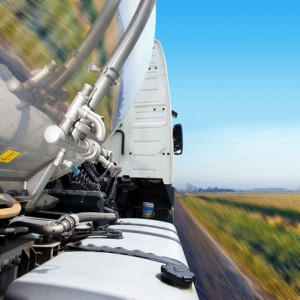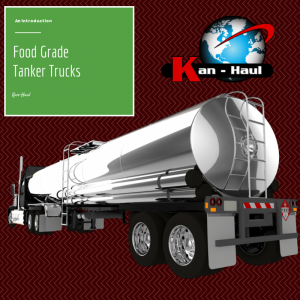 Better Standards, Better Results
Better Standards, Better Results
Kan-Haul is proud to offer a great selection of the newest available technology in the space of food grade tanker companies. This extends to our excellent tank options. Whether you need to transport hazardous materials like alcohol, or require Kosher certified transport for a food product, we have the food grade tank trailer service to meet your needs.
Not only do our tanks conform to the cleanliness standards Kan-Haul has helped shape for food grade tanker carriers, we go above and beyond to ensure the safety and satisfaction of our customers and the consumer who eventually receives the product. The following are just some of the reasons you should consider making Kan-Haul your default food product tank trailer service:
- Rigorous cleanliness standards,
- Decades of experience in shipping and transport,
- Intuitive, user-friendly tracking software, LoadTracker,
- Reliable and Prompt pickup and delivery,
- A variety of top of the line tank freight options
We are confident that we can exceed your transportation expectations, please feel free to contact us to find out whether we have a tank that can meet your transportation needs!
Contact Us
An Intro To Food Grade Tanker Trucking Companies
Maintaining the quality and integrity of cargo is a crucial aspect of product logistics and cargo transportation. Transporters must ensure that their cargo remains intact during transport to prevent damage and protect their bottom line.
The same holds especially true when it comes to the transportation of food. Because of the delicate and perishable nature of food, transporters must take extra precautions to accommodate the special needs of their cargo. To this end, food-grade tanks have emerged as a vital solution for transporting food and food products seamlessly.
Food Grade Tanker trucks are specially designed to safely transport condensed gases, liquid loads, or dry bulk cargo across the country. Learn more about food-grade tanker trucks, their design, and what they can transport below.
What Are Food-Grade Tanks?
Food-grade tanks are specialized containers meticulously designed to ensure safe, hygienic, and efficient transportation of consumable goods. These containers are crucial components of the modern food supply chain. As vehicles used for transport, they effectively protect the integrity of food and food products as they are moved from the production facility to distribution centers for the consumer.
Food-grade trucks are typically made from quality materials while adhering to strict industry standards. Stainless steel is a common material used in food-grade tanks due to attractive qualities like corrosion resistance and ease of sanitization.
What Kinds of Food Can You Carry in a Food Grade Tanker?
What is a tanker truck capable of transporting? There is a wide range of foods and food products that are transported regularly using food-grade tankers. Some tanker trucks haul dry products like sugar, grains, flour, coffee, or tea.
But most often, tanker trucks are used in the bulk transport of liquids, which include the following products:
- Liquid sweeteners
- Fruit juices
- Milk and other dairy products
- Vegetable oils
- Alcohol
- Corn syrup
- Sugar alcohols
- Vinegar
The list of tanker products that a food-grade truck can transport is quite extensive. But before they are loaded onto the truck, the properties of the contents must be considered beforehand to prevent cross-contamination and maintain product integrity and quality.
What is the Capacity of a Food Grade Tanker Truck?
In terms of capacity, a food-grade tanker truck’s carrying capacity will largely depend on its size, design, and intended use. But generally, smaller-sized tanker trucks can hold between 2,000 to 5,000 gallons of liquid products. Meanwhile, larger trucks have capacities that can exceed 8,000 gallons.
Capacity is a major determinant when choosing the type of truck used for hauling liquids. These are selected to suit the specific needs of the transported products while also adhering to regulations and safety standards. Different industries and cargo types may require different tanker truck sizes to ensure efficient and safe transportation while preserving the quality and integrity of the food products.
How Do You Transport Food in a Food Grade Tanker?
Transporting contents in food-grade tanks involves a series of steps to ensure the products are handled safely and efficiently during loading, transport, and unloading. The following are some key steps involved in food transport:
- Tank Preparation: The tank undergoes a series of cleaning and sanitation procedures to eliminate possible sources of contamination.
- Cargo Loading: Specialized pumping systems and hoses load the contents into designated compartments inside the tank.
- Temperature Control: Special temperature regulation systems ensure the cargo is maintained within ideal temperature ranges for peak quality.
- Compartmentalization: The cargo is loaded into specific compartments to prevent cross-contamination.
- Transport: Once the cargo is secured, the tanker truck will travel across the country to reach its intended destination.
- Monitoring and Compliance: The tanker and its cargo are monitored throughout the journey to ensure the right conditions are met and maintained.
- Unloading: Upon reaching the destination, specialized hoses and pumps are used again to unload the cargo from the truck into special holding tanks.
- Cleaning and Sanitation: After unloading, the tanker goes through another round of cleaning and sanitization in preparation for the next load.
Food-grade tanker trailers must meet stringent safety and sanitation codes before being certified to transport foods. Some common examples of the strict requirements are listed below:
- Tamper-Evident Seals must be single-use, non-resalable, virtually impossible to tamper with, easy to identify, and constructed of non-toxic, non-corrosive, cinchable material.
- Cleaners of food-grade bulk tanker carriers must make sure to sanitize themselves before cleaning the tank. Then, they must seek confirmation from a third party to certify that the tank is clean.
More about the sanitation guidelines can be found here.
How Do You Keep Liquids in Food-Grade Tanks From Freezing?
One of the key challenges when transporting in food-grade tanks is the risk of freezing, especially during colder months. Certain food products are susceptible to freezing temperatures, which can alter their quality or even lead to spoilage.
A combination of insulation, heating systems, and temperature control measures are employed to mitigate this risk. Tanks designed for cold-weather transport have heating elements that prevent the contents from freezing during transit. These systems are carefully monitored to ensure the temperature remains within the appropriate range for the cargo.
Tanker Designs
What is a tanker truck’s most distinguishable feature? Tankers are best distinguished by their cylindrical shape, which has been shown to provide key benefits during bulk transportation. Less common characteristics include:
- the tank’s compliance with human food regulation standards
- refrigeration capabilities
- acid resistance
- pressurization capabilities
The largest vehicles in the tanker family are those that are similar to railroad tank cars that are designed specifically for liquid loads. Other tanker truck types also exist, each adapted to the different types of loads transported by the vehicle. Unfortunately, these vehicles can be challenging to drive and may require special skills due to their high center of gravity.
Contact Us For Food Grade Transport Today!
Tanker trucks are a critical part of our food delivery system, allowing for quick, safe delivery of perishable goods to stores nationwide. If you want to work with one of the best food grade tanker trucking companies, call Kan-Haul at (800) 959-9501 or fill out our online form.


